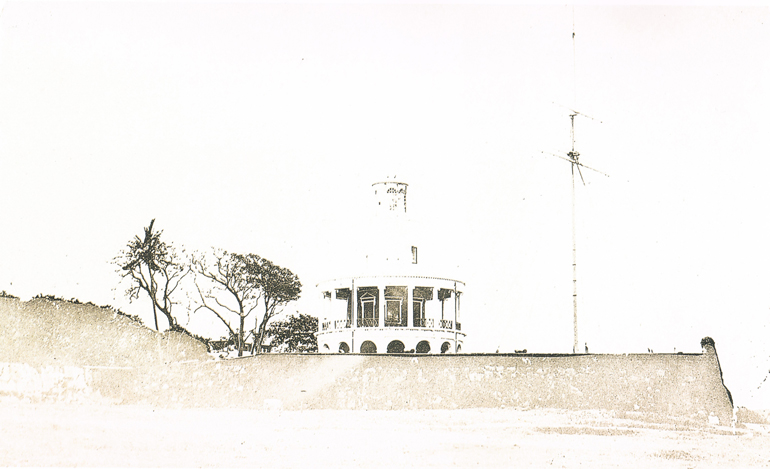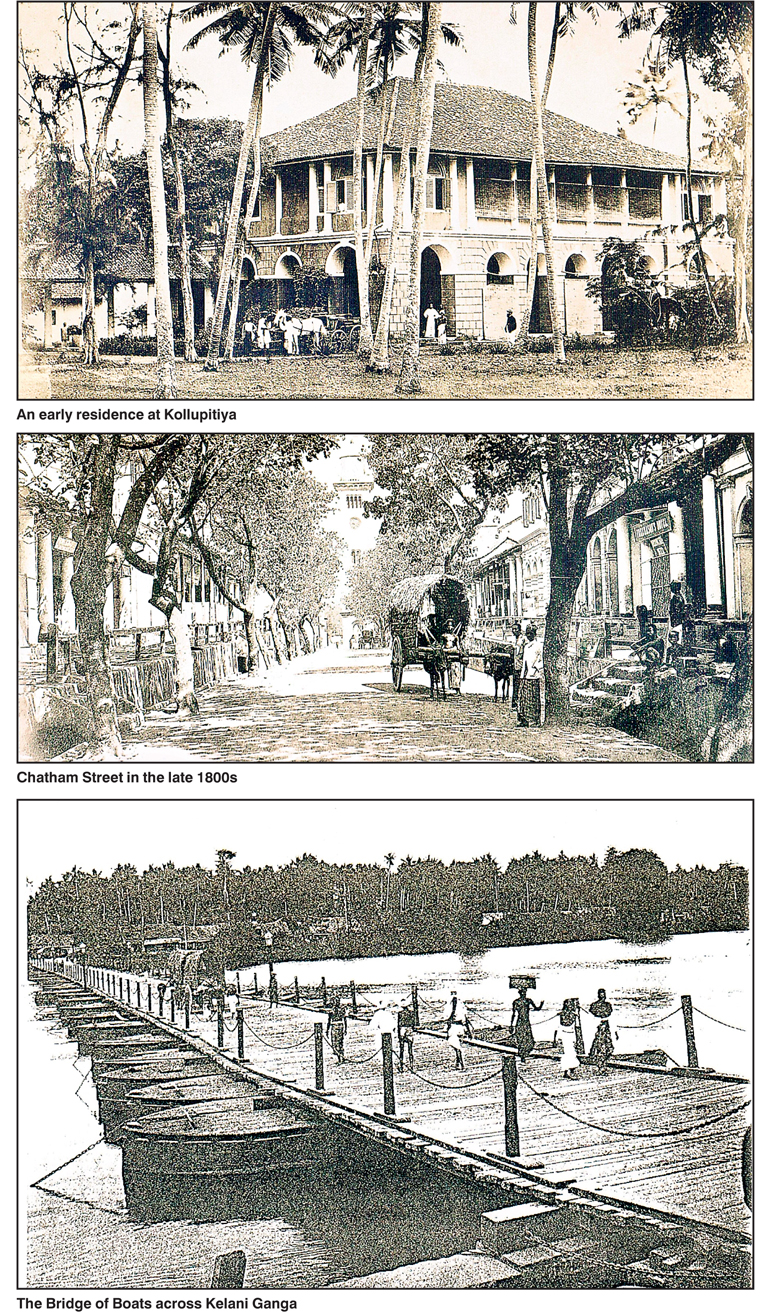Wednesday Feb 12, 2025
Wednesday Feb 12, 2025
Saturday, 20 June 2015 00:10 - - {{hitsCtrl.values.hits}}

First light house at Galle Buck in Fort
By D.C. Ranatunga
Looking back on the progress of Colombo, the Dutch had started a systematic planning process in turning Colombo into a city to be proud of. Mansions (‘walauwes’) were constructed by individuals based on traditional Dutch architecture some of which can be seen to this day.
The last Dutch Governor, Van Angelbeck, had built a mansion at the site where the present President’s House is located. It was occupied by the second British Governor, Sir Thomas Maitland (1805-11) and came to be known as the ‘King’s House’ – as he represented the British monarch who, at the time, was King George III.
The building was later demolished and a new governor’s residence built. It came to be the ‘Queen’s House’ after Queen Victoria ascended the throne. The name continued until Ceylon became a Republic and the name changed to President’s House and Queen Street came to be known as Janadhipathi Mawatha.
The Dutch Hospital and one time Pettah Post Office, later converted to the Dutch Museum, are two other examples of the buildings built by the Dutch.
Although during the Portuguese and Dutch periods there were threats of attack internally and externally, once the British captured King Sri Wickrema Rajasinghe and then took over the Kandyan kingdom in 1815, they had no worries about an internal attack. Externally too, they had established themselves as a superior power. Colombo then became the capital of the entire island.
‘Passa Grande’ and ‘Pasbetal’
The Kelani Ganga virtually cut off the city on one side and it was by ferry at two places that people got across when they had to go towards either Negombo or Kandy.
Renowned researcher and writer R.L. Brohier describes the two ferries in his book ‘Changing Face of Colombo’: “The Portuguese bestowed the connotation ‘Passa Grande’ to the crossing at Nakalagam which explains the origin of its present name ‘Grand-pass’. The second crossing called ‘Pasbetal’, literally ‘Pass of the boats’, was not far from Grand-pass, but nearer the mouth of the river. At both ferries toll was levied and as the record has it: ‘excellent boats with capacious decks on to which a one-horse carriage could be driven, conveyed vehicles and passengers across’.”
It was from the latter ferry that British troops had crossed the river when they marched from Negombo to take over the Dutch Fort in Colombo. It had also been used for the constant movement of troops during the wars against the Kandyan King.
The pontoon bridge
It was in 1822 that the pontoon bridge – ‘Paaru Paalama’ – Bridge of Boats was constructed. The bridge designed by Lieutenant-General John Frazer was constructed under his supervision and soon became a landmark in the city for over 70 years.
The wooden bridge consisted of 21 boats anchored side by side and linked by crossbeams and a platform 500 feet long and 20 feet wide. Two boats could be taken out daily to allow the river traffic – padda boats taking goods – to pass through. There were instances when a boat got loose and was carried to the sea.
Meanwhile work on a second bridge was started and completed in 1865. It was a lattice girder bridge in seven spans of 100 feet each with a roadway 26 feet in width. The bridge opened on 24 May 1865 was named Victoria Bridge to commemorate the British monarch, Queen Victoria. As the years went by, traffic increased and the new Kelani Bridge was built and opened in 1959.
Beira Lake
The Beira Lake was yet another landmark in the city. The name is supposed to have derived by the name of a Dutch engineer called De Beer who had constructed the moats and water defences in Colombo.
The lake had originally been an extensive reach of flood water from the Kelani Ganga. In the early days of British rule, the lake had been used for water sports. Small sailing vessels and boats had been seen frequently. Villas had been built by the lakeside and regular evening parties had been held when friends gathered and enjoyed themselves.
Henry W. Cave describes the fresh-water lake as one of the most charming features of Colombo. “Its ramifications are so many that one is constantly coming across pretty nooks and corners quite unexpectedly, each fresh view presenting a wealth of foliage luxuriant beyond description. Palms in great variety intermingle with the gorgeous mass of scarlet flamboyant blossoms, the lovely lemon-yellow lettuce tree, the ever-graceful bamboo, the crimson blossoms of the dark hibiscus, contrasting with the rich green of the areca, date and Palmyra palms, huge waving leaves of the plantain, flowering trees and shrubs of every description of tropical foliage, the whole forming to the rippling water a border unrivalled beauty and unfailing interest,” he wrote at the dawn of the 20th century.
Park lands and open spaces had been a feature in the city. Racket Court, for example, was described by Brohier as “a place where in the evening hours, which time the streets were daily watered and the air after the burning heat of the day, the young ladies rendezvoused to display their pretty frocks and figures”. Later on, this practice would have moved over to Galle Face Green.
Galle Face
Galle Face was used as the racecourse when horse racing began in the early 1820s during the time of Governor Sir Edward Barnes. The area was a marshy land which was filled with earth and levelled for use as a racecourse which was about one-and-a-half miles long.
A pavilion was erected at the highest point of the green to view the races. To begin with, it was circular in shape with wooden framework and a thatched cadjan roof. Later the wooden walls were replaced by bricks. A viewing gallery known as the ‘Grand Stand’ was added in 1870, which was enlarged into a two-storey grand stand. In 1870 it became the venue of the Colombo Club. It is today the Crystal Ballroom of the Taj Samudra Hotel.
Known as the ‘Colpetty Race Course,’ the Galle Face racecourse remained so until 1893 when it was moved. The green came to be used by the public as a recreation ground for football, cricket, hockey and other games.
Obviously Colombo had been a beautiful place in the early days of the British administration for writers to describe it as “the most charming place of all – with beautiful flowering plants and shady walks under the sprawling branches of almond (‘kottam’) trees”.
Pix courtesy ’Images of
British Ceylon’

Discover Kapruka, the leading online shopping platform in Sri Lanka, where you can conveniently send Gifts and Flowers to your loved ones for any event including Valentine ’s Day. Explore a wide range of popular Shopping Categories on Kapruka, including Toys, Groceries, Electronics, Birthday Cakes, Fruits, Chocolates, Flower Bouquets, Clothing, Watches, Lingerie, Gift Sets and Jewellery. Also if you’re interested in selling with Kapruka, Partner Central by Kapruka is the best solution to start with. Moreover, through Kapruka Global Shop, you can also enjoy the convenience of purchasing products from renowned platforms like Amazon and eBay and have them delivered to Sri Lanka.
Discover Kapruka, the leading online shopping platform in Sri Lanka, where you can conveniently send Gifts and Flowers to your loved ones for any event including Valentine ’s Day. Explore a wide range of popular Shopping Categories on Kapruka, including Toys, Groceries, Electronics, Birthday Cakes, Fruits, Chocolates, Flower Bouquets, Clothing, Watches, Lingerie, Gift Sets and Jewellery. Also if you’re interested in selling with Kapruka, Partner Central by Kapruka is the best solution to start with. Moreover, through Kapruka Global Shop, you can also enjoy the convenience of purchasing products from renowned platforms like Amazon and eBay and have them delivered to Sri Lanka.